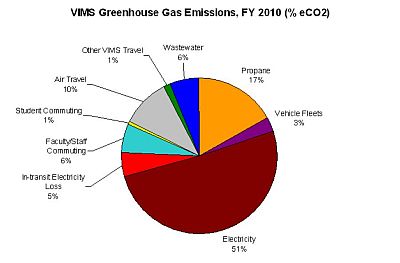Summary of VIMS Greenhouse Gas Emissions
 The results from the carbon calculator show that electricity and propane usage are by far the major sources of our greenhouse gas emissions. The seasonal pattern of use (increased propane use in summer and electricity use in winter, particularly in Chesapeake Bay Hall and Andrews Hall) suggest that heating and cooling are major areas of use for these resources. Therefore, increasing heating and cooling efficiency on campus should be a top priority, including evaluating ways to increase efficiency, as well as the possibility of retrofiting systems in current buildings.
The results from the carbon calculator show that electricity and propane usage are by far the major sources of our greenhouse gas emissions. The seasonal pattern of use (increased propane use in summer and electricity use in winter, particularly in Chesapeake Bay Hall and Andrews Hall) suggest that heating and cooling are major areas of use for these resources. Therefore, increasing heating and cooling efficiency on campus should be a top priority, including evaluating ways to increase efficiency, as well as the possibility of retrofiting systems in current buildings.
The implementation of energy-efficient heating and cooling systems should be emphasized in planning future buildings. In order to keep better records of travel by VIMS personnel, both for the purposes of future Greenhouse Gas Inventories and for standardized documentation of travel, either a mandatory quarterly survey of all travel should be implemented or exact mileage should be reported on travel forms and compiled into an inter-departmental spreadsheet. Emissions related to commuting to VIMS could be decreased by encouraging carpooling by setting up a carpool page on the VIMS website, where those interested in participating could find other individuals living near by. Additionally, special parking spaces could be established for those who carpool (with at least 3 individuals per vehicle). Additional bike racks could also encourage students, faculty, and staff to use a bicycle instead of a car.
Another way to potentially decrease energy use on campus would be the implementation of a competition between buildings to see if the individuals in that building can reduce their energy consumption the most. An award could be hung in the winning building until the next session of the competition. Using biodiesel from local sources in on-campus machinery (i.e. lawnmowers) and some boats would further reduce emissions. Switching to B20 biodiesel fuel would cut greenhouse gas emissions from diesel use by 21%. The on-campus production of solar and wind energy thought the installation of solar panels and wind turbines on top of the buildings on campus could also reduce our dependence on purchased electricity (reducing energy loss in transmission lines) and allow VIMS to play a leading role in the shift to clean energy production in the community.

